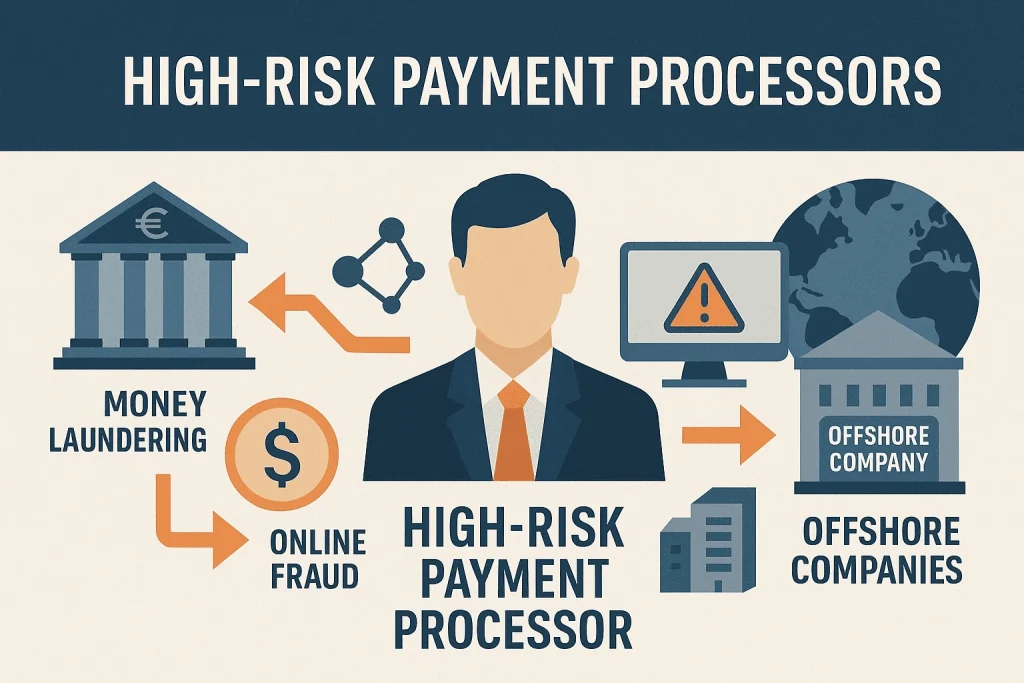The Central Role of High-Risk Payment Processors in Online Fraud
High-risk payment processors (HRPPs) are frequently identified as core facilitators in cybercrime schemes and online investment fraud. These entities often play a critical role in enabling consumer fraud and laundering the proceeds. A landmark example is the 2020 conviction of Gal Barak in the Vienna Cybercrime Trials (VCT), where he was sentenced to four years in prison for investment fraud and money laundering related to an international broker network.
The findings from the VCT, based on extensive forensic financial investigations and cross-border collaboration among European authorities, have offered insight into how payment processors such as Payvision and iPayTotal allegedly operated within larger networks of illicit finance.
Vienna Cybercrime Trials: A European Reference Case
The VCT represents a significant legal benchmark in Europe. Investigations and prosecutions are ongoing across multiple jurisdictions against alleged fraud operators and their financial enablers. Gal Barak’s sentencing in Vienna marked the beginning of a broader legal push. His partner Marina Barak (née Marina Andreeva) is also expected to stand trial.
Additionally, the German authorities have filed an extradition request, signaling further prosecution efforts beyond Austria. Evidence reviewed in court shows that some payment processors were aware of the nature of the transactions they facilitated, yet continued operations.
Payment Processor Accountability in Court Findings
The official court ruling from the VCT states that Payvision, a Dutch payment processor and former subsidiary of ING, was involved in processing funds connected to Barak’s activities. Payvision is noted to have handled millions in customer funds, part of which were allegedly withheld or forfeited without reimbursement.
This example highlights a broader concern: some payment processors reportedly retained illegal proceeds, even from clients running fraudulent schemes, for their own profit.
Understanding the HRPP Business Model
It is essential to clarify that not all high-risk business models are inherently illegal. Some operate lawfully in select jurisdictions, even when prohibited elsewhere. For instance, online gambling or cannabis-related services may be fully licensed in one region but remain restricted in another.
However, platforms engaged in fraudulent investment schemes, such as those tied to binary options, fall under illegal classifications in nearly all regulatory environments. Despite this, they often find access to global payment infrastructure via high-risk processors.
Key features of HRPP involvement typically include:
-
Serving merchants lacking access to standard financial services
-
Facilitating credit card payments despite regulatory risks
-
Opening offshore bank accounts or establishing shell entities
-
Misclassifying transaction types to obscure true business activities
Offshore Structures and Fund Diversion
To bypass compliance scrutiny, many HRPPs use offshore banks and shell companies to open accounts and disguise illicit transactions as legitimate consultancy or licensing fees. Some even partner with companies from unrelated sectors to create the appearance of legitimate activity.
There is also a notable trend involving cryptocurrency-based services, where newer HRPPs operate in the gray zone, offering clients access to crypto-fiat rails with limited transparency.
Common Risks and Merchant Challenges
A recurring issue in this sector is the unilateral withholding of merchant funds. When financial regulators begin inquiries or consumer complaints escalate, HRPPs may freeze or retain balances without warning. Merchants who operated in the gray market—or those linked to illegal operations—have limited legal recourse to recover funds.
This dynamic leads to:
-
Fund retention without due process
-
Abrupt termination of service contracts
-
Lack of dispute resolution for high-risk merchants
Due to the nature of the industries served, legal action is rarely pursued—even when large sums are withheld.
Next in the Series: Case Studies
The upcoming installments in this series will present detailed case studies involving specific merchants, payment processors, and legal outcomes. These examples aim to clarify how high-risk processing infrastructures operate, and the compliance risks that financial institutions face when engaging in or acquiring such entities.


